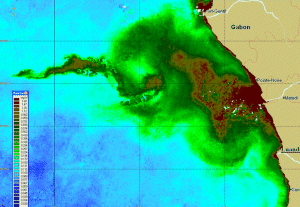Chlorophyll content of the ocean
Phytoplankton ('plant' plankton) is the first link in the marine food-chain and is the basic food supply for most fish. This phytoplankton contains chlorophyll, the origin of oceanic photosynthesis; it absorbs atmospheric CO2 and releases oxygen due to the effects of solar light. Among all of the terrestrial vegetation, Phytoplankton produces more of the planet's oxygen than all of the land-based vegetation.
The long term management of marine resources has become a major preoccupation for our societies; today, knowledge of the chlorophyll content in the ocean's superficial layers is a precious indicator of the marine food chain's primary production and the state of health of the planet's oceans.

ocean colour map for 18/01/2011 over the "Crush" penguin zone. The light zones correspond to places where phytoplankton is abundant; and, in fact, if we look at the corresponding oceanic currents or topographic maps, they correspond to ocean eddies and to the meandering currents (ACRI/EU Copernicus Marine Service - Figure Argonautica)
Orders of magnitude
The ocean's chlorophyll content is measured in mg/m3. It varies from 0.03 mg/m3 in the immense zones of chlorphyllous desert (oligothropic zones) in the big oceans (north and south Pacific and Atlantic and the south Indian) up to more than 10 mg/m3 in the limited eutrophic zones of coastal upwelling (Peru and Mauritania) or during blooming seasons in the higher to medium latitudes.
.Measurement techniques
Satellite measurements
Ocean colour is measured using optical radiometers which are sensitive to the long wavelengths of solar energy reflected by the ocean's surface. It allows an estimation of the chlorophyll content in the ocean.
Models
Over the past years, we have seen the emergence of models simulating the concentration of chlorophyll. In future years, coupled with ocean physical models, their improvement will allow forecasting of the primary production a few months ahead of time. Coupled with "biogeochemical" models, we are now seeing the arrival of complete marine ecosystem models covering everything from the emergence of phytoplankton to huge pelagic fish (tuna, for example).


